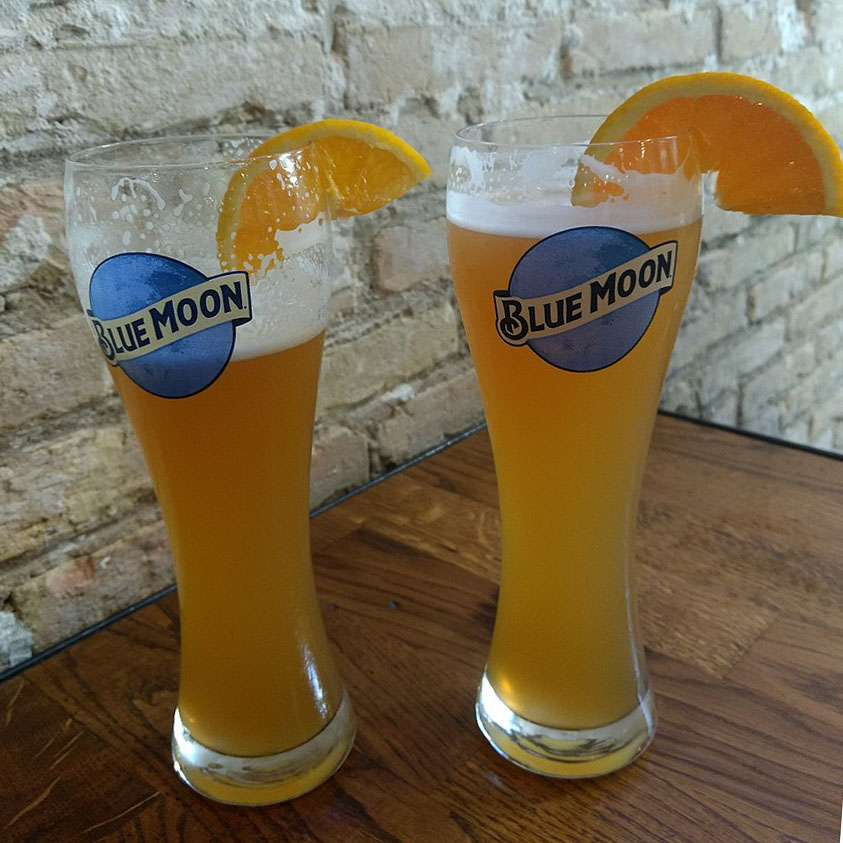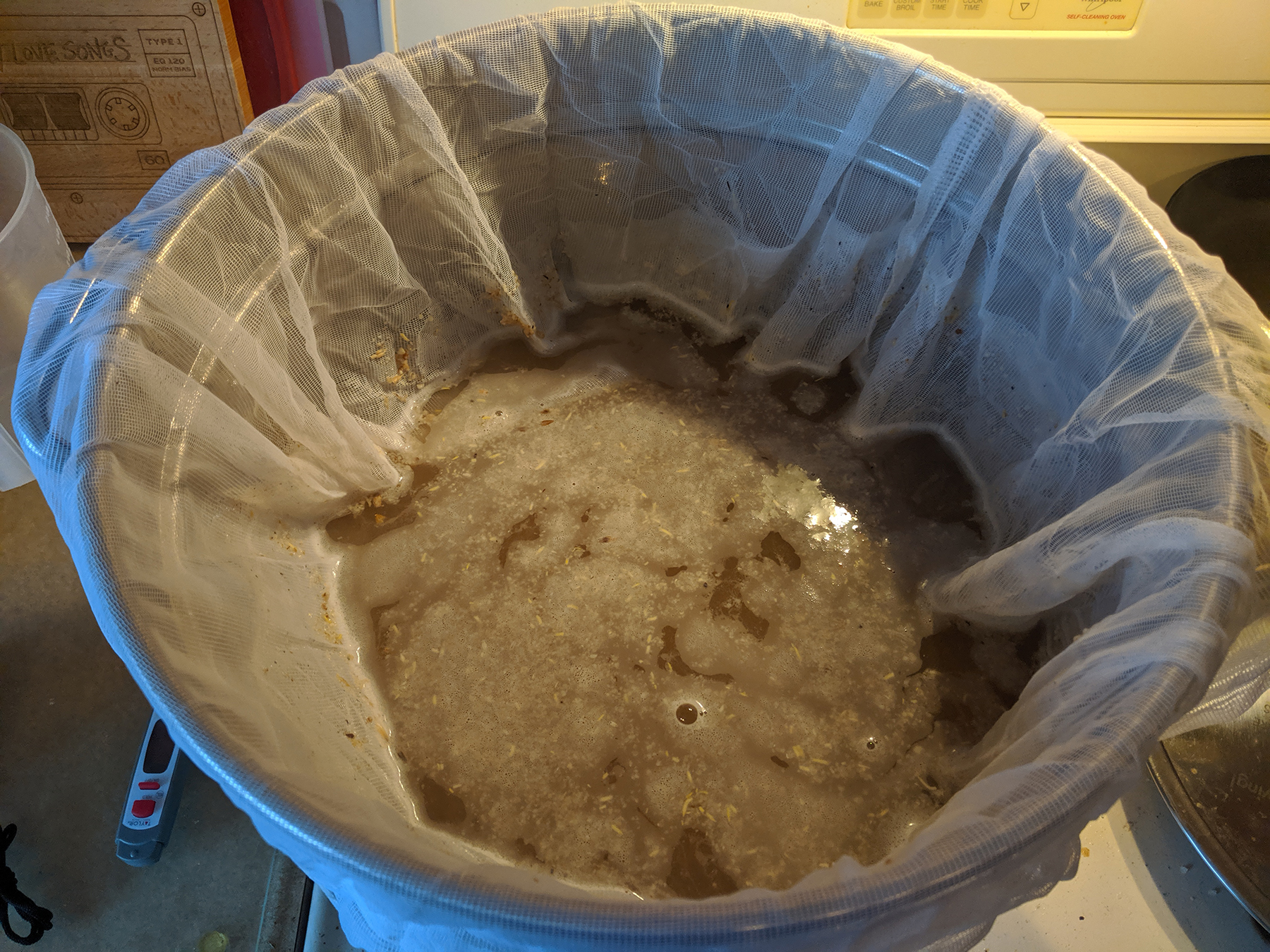Belgian Witbier
by Ben Centra
Belgian witbiers were early favorites of mine as I was getting into beer. Blue Moon, of course, plus the original Hoegaarden and craft favorites Ommegang Witte and Allagash White. The flavors of the belgian yeast, orange peel, and coriander set it apart from other styles of beer while maintaining the friendly, refreshing taste of a crowdpleaser.
Blue Moon, an American example of the Belgian Witbier style. (From Wikimedia Commons)
Although I’ve done my own Blue Moon clone in the past, this recipe comes modified from Brewing Classic Styles by Jamil Zainasheff and John Palmer. A lot of my upcoming posts will be based on recipes found in that book. Practicing with “classic” styles will be a great way to refresh myself on brewing basics as well as try a few new beer styles. I’m curious to see how less coriander and the addition of chamomile from their witbier recipe turns out.
Specs
| Style | Witbier (BJCP 24A) |
| Recipe Type | Extract |
| Batch Size | 3 Gallons |
| Original Gravity | 1.048 |
| Final Gravity | 1.012 |
| ABV | 4.8% |
| Color | 7 SRM |
Ingredients
The ingredients for our Belgian Witbier. Based on "Wittebrew" from the book Brewing Classic Styles, which adds chamomile to the traditional orange peel and coriander.
| Fermentables | ||
|---|---|---|
| Kind | Amount | Color (SRM) |
| Wheat Liquit Malt Extract (LME) | 3.3 lb | 8°L |
| Flaked Oats | 10.7 oz | 1°L |
| Belgian Pils (2-Row) | 9.6oz | 2°L |
| Munich Malt | 2.4 oz | 9°L |
| Hops | |||
|---|---|---|---|
| Kind | Amount | % AA | Time |
| Hallertau | 0.7 oz | 4% | 60 min |
| Other | |||
|---|---|---|---|
| Kind | Amount | Stage | Time |
| Sweet Orange Peel | 0.9 oz | Boil | 5 min |
| Coriander Seed (crushed) | 0.3 oz | Boil | 5 min |
| Chamomile Tea (dry) | 0.03 oz | Boil | 5 min |
| Yeast | |
|---|---|
| Kind | Amount |
| White Labs WLP400 “Belgian Wit Ale” | 1 package (40 mL) |
The orange peel and coriander are traditional for this style, and this recipe adds chamomile.
Witbiers often use bitter orange peel, but the original recipe actually calls for fresh orange zest. I compromised with the equivalent amount of sweet orange peel. The recipe also suggests you crush the coriander to increase the surface area contact with the water. The chamomile from tea bags will work, as long as there aren’t any other additives or ingredients.
Recipe
Start by adding 3 gallons of water into your brew kettle. Bring the water up to 155°F, turn off the heat, and steep the flaked oats, Belgian pils, and Munich malts for at least 15 minutes. In an extract brew, the steeping malts are more for color and flavor than fermentable sugar. After steeping for 15 minutes I did a quick sparge with one quart of 170°F water, but this step is optional. Remove the grain from the kettle and discard.
I steep the grains in a mesh bag, which gives the grain more contact with the water.
Turn on the heat and bring the wort to a boil. While heating up, stir in the wheat LME until it is completely dissolved. Boil the Hallertau hops for 60 minutes, adding the orange peel, coriander, and chamomile during the last five minutes. After the boil is complete chill the wort down to about 70°F. Filter out the hops and spices as you transfer the wort to your fermenter.
I kept my hops and spices in muslin bags for easy removal before using my wort chiller to quickly cool the wort.
At this point, check your gravity! I lost a full gallon during the boil, dropping from 3.25 to 2.25 gallons, and my gravity was a bit high at 1.060. I added another quart of water to achieve a gravity of 1.054 at 2.5 gallons. A bit off from target, but I felt it was close enough! Finally, pitch the yeast into the wort and seal with an airlock.
Primary fermentation winding down after about a week. As the original recipe suggests, I kept my A/C on to maintain an approx. 72°F room temperature during that time.
Let the beer sit in primary fermentation for about a week. When fermentation has slowed, transfer to a secondary fermenter for another week or so. After two weeks it should reach its target gravity and be ready for bottling. Use 1 oz of priming sugar per gallon of beer for carbonation. After two more weeks, the beer is ready to drink!
Result
And here it is, the belgian witbier!
A bit darker than expected, but the flavors are close.
Let’s break down the finished product with a proper beer tasting:
| Appearance | Somewhat hazy, amber color is dark for the style |
| Aroma | Malt sweetness, orange comes through, light hint of spice |
| Mouthfeel | Semi-sweet, somewhat syrupy, coats the mouth, no alcohol burn |
| Flavor | Sweet orange comes through, coriander mostly lost in the malt, some yeast character, can’t really taste the chamomile |
| Overall | More body than expected, but still light and sweet. Balance could be tipped more towards spice next time. |
Based on the source recipe, this is a less traditional witbier. The darker color is mostly from the liquid malt extract, which tends to run darker than the whole grain equivalent. I think my estimation for the sweet orange peel amount was too high, overpowering the coriander and chamomile. It’s still a sweet and enjoyable beer, though next time I might cut back on the orange a bit and even bump up the coriander.
For an unfair comparison but an excuse to drink a favorite beer, I sampled my witbier alongside Allagash White.
My witbier on the left, Allagash White on the right.
White has the pale straw color of a more classic witbier, whereas mine is even darker than a Blue Moon. It has a similar hazy appearance. The aroma is less sweet, with more grass and spice notes coming through. White is drier and lighter in body than my witbier, which to me makes White more refreshing. It has better balance of sweetness and spice, trading lots of orange sweetness for coriander, pepper, and clove notes.
While the color will be harder to match with extract, I can certainly take a lesson from Allagash in balancing the various flavors present in belgian witbiers in my next attempt!
Subscribe via RSS








